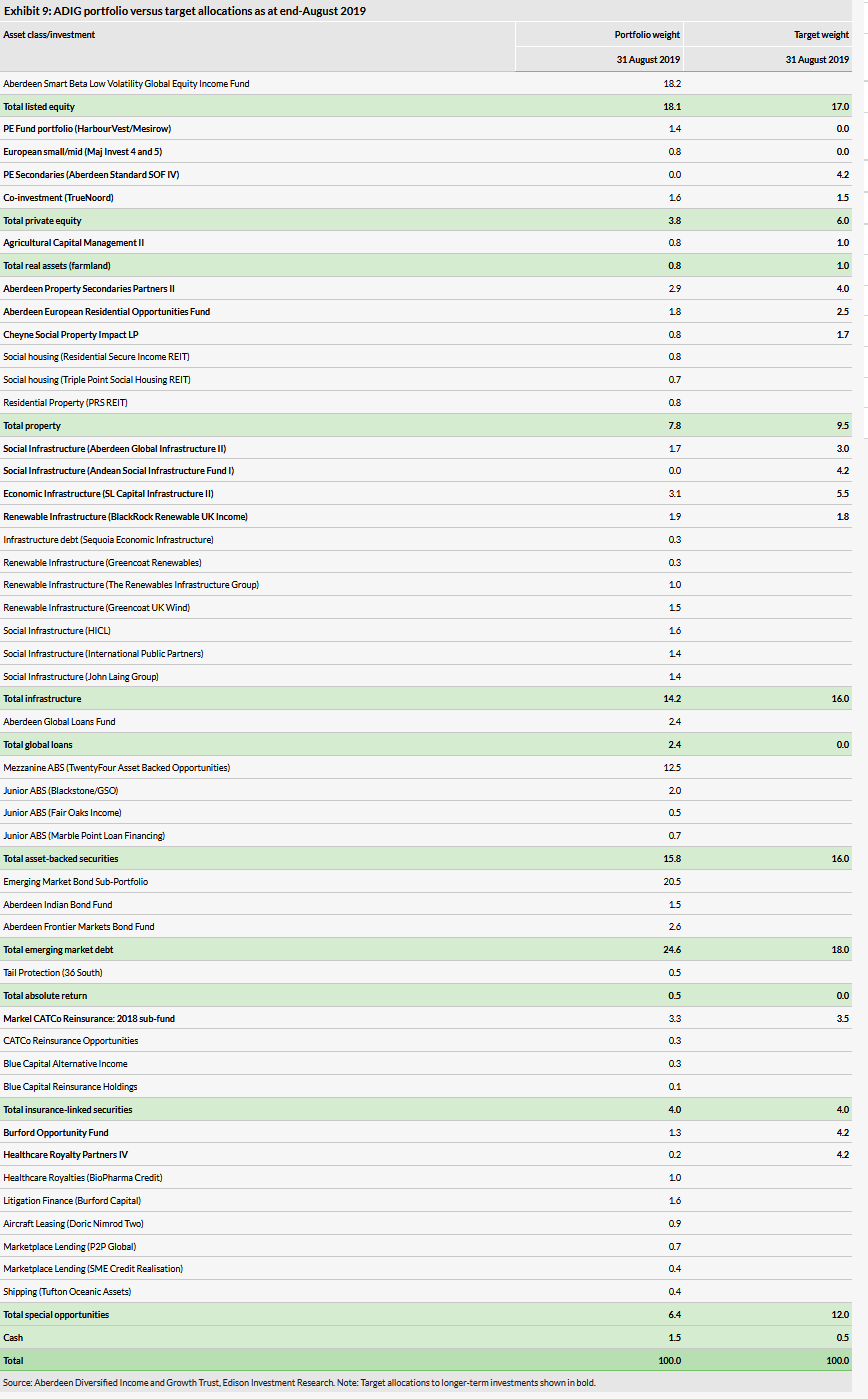Aberdeen Diversified Income and Growth Trust (Aberdeen Diversified Income and Growth Trust PLC (LON:ADIG)) continues to progress towards full implementation of its strategy, aiming to achieve attractive capital and income returns (five-year target of Libor +5.5% pa, net of fees) from a widely diversified multi-asset portfolio, including a significant allocation to less liquid, longer-term investments that individual investors would be unlikely or unable to access. Portfolio managers Mike Brooks and Tony Foster at Aberdeen Standard Investments (ASI) say half the funds committed to these long-term strategies have now been drawn, with the pace of investment from underlying managers stepping up over the summer. As the portfolio develops towards its intended shape, there is scope for the current wider-than-average discount to narrow materially. ADIG’s shares have an FY19 prospective yield of 5.0%.
ADIG’s performance has improved recently versus target and UK equities
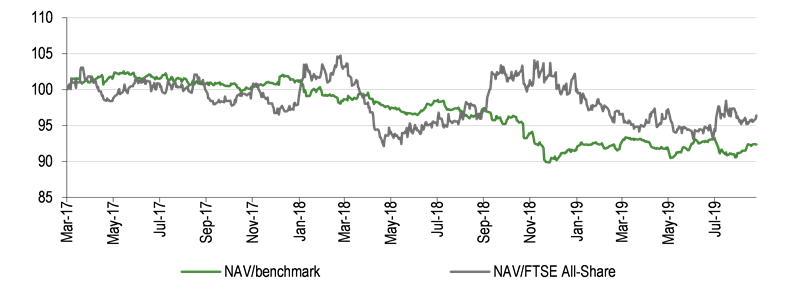
Share Price/Discount Performance
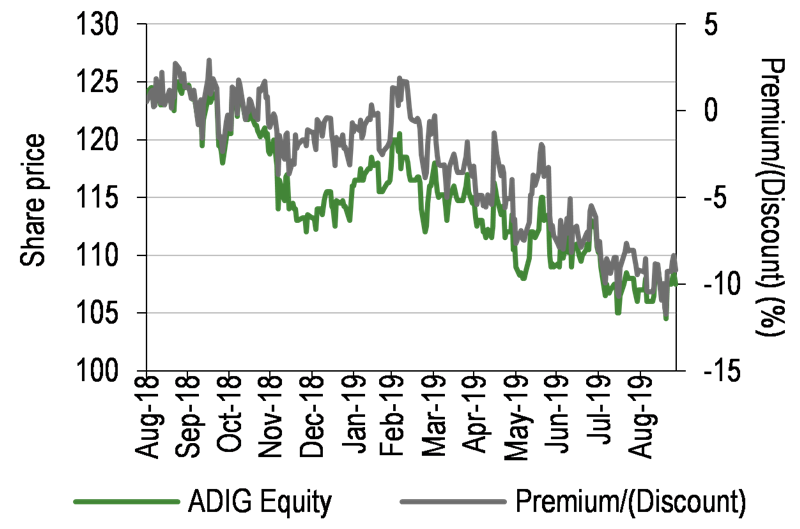
Three-year performance vs index

The market opportunity
The equity bull market has now endured for more than a decade, while government bond yields remain close to all-time lows. With many economic indicators turning down, and an abundance of worrying geopolitical factors, investors may wish to consider a diversified multi-asset portfolio with a wider range of risk/return drivers.
Why consider investing in ADIG?
A diversified portfolio blending more liquid investments with long-term holdings in hard-to-access asset classes offering different risk/return drivers.
Access to the best ideas from across ASI’s global investment platform (c 56% of assets) along with externally managed funds (c 44%).
While returns have so far been short of the absolute target of Libor +5.5% (net of fees), progress towards full investment in the long-term portfolio (target of c 40% of assets, currently 21%) should boost performance in the medium term.
Wider-than-average discount and attractive yield
At 26 September 2019, ADIG’s shares traded at a 9.2% discount to cum-income NAV. While this was narrower than the recent one-year high of 11.8%, it is wider than both short- and long-term averages (range of 3.2% to 4.8%). With disappointing performance from holdings in insurance-linked securities and litigation finance now arguably fully reflected in the price, there is scope for the discount to narrow as the portfolio progresses. Meanwhile, the shares yield an attractive 5.0% (prospective).
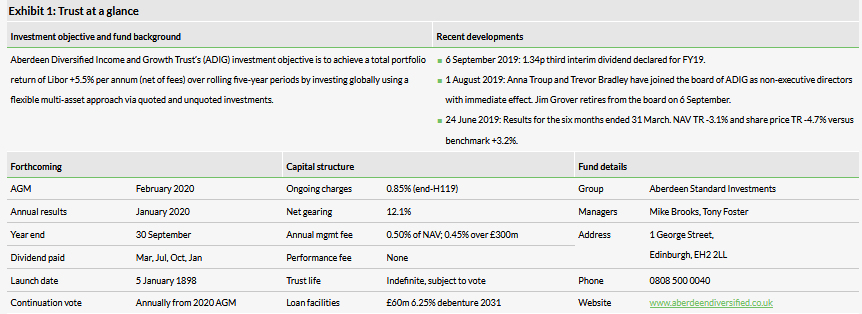


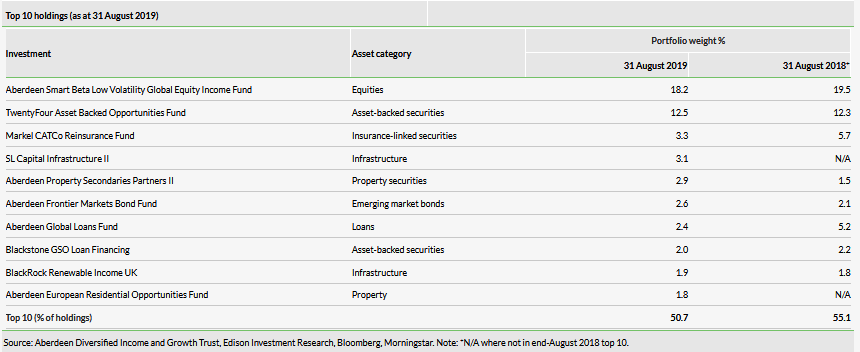
Fund profile: Multi-asset income and growth portfolio
ADIG began life in 1898 as British Assets Trust (BSET), which until February 2015 was a global equity income investment trust managed by F&C Investments (now BMO Global Asset Management). The mandate then moved to BlackRock (NYSE:BLK) and the trust became BlackRock Income Strategies (BIST), a multi-asset strategy with an absolute return focus. After a period of disappointing performance, a strategic review was undertaken, resulting in Aberdeen Asset Management (now Aberdeen Standard Investments) being appointed as manager in February 2017. The trust was renamed Aberdeen Diversified Income and Growth Trust, and was enlarged by a merger with Aberdeen UK Tracker Trust. (See our initiation note for more detail on the changes implemented in 2017.) It retains a multi-asset, absolute return approach, but now invests in a more diverse portfolio including longer-term, less liquid investment funds that individual investors would otherwise be unlikely or unable to access. ADIG aims to achieve total annual portfolio returns of Libor +5.5% (net of fees) over rolling five-year periods. With Libor due to be phased out by 2021, the manager is in the process of identifying an alternative performance measure. ADIG is a member of the Association of Investment Companies’ Flexible Investment sector.
The trust is managed by Mike Brooks and Tony Foster, who are respectively the head of Aberdeen Standard Investments’ (ASI) diversified assets team, and an investment director within the team. Brooks developed ASI’s institutionally focused Aberdeen Diversified Growth Fund, which follows a similar approach to ADIG but has a slightly lower return target of Libor +4.5% pa (net of fees), as ADIG’s closed-ended structure allows it to invest in less liquid assets, and it is also able to use gearing (up to 20% of net assets). ASI says the open-ended fund has grown its assets under management from £150m when Brooks took it over in the first quarter of 2015 to c £700m today.
The fund managers: Mike Brooks and Tony Foster
The managers’ view: Continuing to build long-term exposure
In line with ADIG’s primary aim of offering its shareholders long-term investments in hard-to-access asset classes with different risk/return drivers, portfolio manager Tony Foster explains that the management team is continuing with the process of recycling capital from listed to unlisted holdings as the underlying fund managers continue to identify appropriate projects. ‘Now that we are two-and-a-half years in, we have c 21% invested in unlisted, and commitments to 40% in total,’ he says. ‘So we are 50% [of our target] invested, although it has been a bit slower than anticipated, reflecting that, for the managers to whom we have committed funds, it can be a slow process to identify the appropriate investments. However, we have been pleased with the pace of investment of late.’ Foster argues that it is easy to spend money quickly, but the ADIG team wants the underlying fund managers to ‘spend it properly’.
An example of how the managers are recycling capital from listed to unlisted funds is ADIG’s $25m commitment to Healthcare Royalty Partners IV, where the trust’s managers intend to reduce their holding in the listed (and hence easy to access) fund BioPharma Credit (BPCR) as the unlisted fund draws down capital. Foster explains that BPCR lends money against royalties, so the research institutions that have licensed the drugs they have discovered to pharmaceutical companies can use their royalties as collateral against loans used to fund future research and development. Healthcare Royalty Partners has a slightly different return profile, as its modus operandi is typically to buy out the royalty stream so that it owns the future royalties as they come through. The manager says the unlisted fund targets 10–12% annual returns, while BPCR aims for c 8% or so. ‘Healthcare Royalty Partners is slightly higher risk, in that royalties may be higher or lower than anticipated, but the managers have a good track record. So far, they have made three investments and at the moment we have only invested c $1m or so of our $25m commitment, but they are already returning income to us.’
In terms of the broader market outlook, Foster notes that bond yields are still very low in developed markets, equity valuations are still generally high, and there is ‘plenty to worry about’ in the macro and geopolitical backdrop. ‘As a result we feel that taking a diversified approach to building a portfolio with a wide range of return drivers and risk characteristics remains appropriate,’ he adds. ‘We are aiming for low volatility. Returns have been below-target so far, primarily because of the weakness of our insurance-linked investments, but also because of the time it is taking to get fully invested in our unlisted funds. We are still only halfway there – at 21% versus commitments of 40%, and some of those are returning capital already – but the portfolio is moving nicely into position. Ultimately we need our unlisted holdings to be more substantial in size, and realise those double-digit returns that we anticipate from them going forward.’
Asset allocation
Investment approach: Finding best ideas in-house and externally
ADIG aims to generate highly attractive long-term capital and income returns by pursuing a truly diversified multi-asset approach, using quoted and unquoted investments, with no geographical or sector restrictions. The core of the philosophy is to provide investors with long-term investment opportunities in hard-to-access asset classes with different risk/return drivers. Robust risk management is embedded in the ASI multi-asset team’s investment approach, not just through maintaining an appropriate level of portfolio diversification, but also through the use of detailed due diligence, specialist quantitative risk tools, ongoing scenario analysis, liquidity stress tests and peer review of investment ideas within the investment team.
Asset allocation is flexible. ADIG’s board and managers believe equities should form a core, but not dominant part of any growth or income portfolio, leading to a target weighting of 20–30% across listed and private equity. Given their current historically low yields and inflated prices, developed market government bonds and investment-grade credit are not expected to feature in the near term. However, emerging market bonds are viewed as a more attractive area. ADIG’s portfolio contains both ASI-managed and external funds, with the expectation that c 60% will be in internally managed funds or direct investments, and c 40% in third-party managed funds.
ASI has a global investment platform with over 1,000 investment professionals across teams specialising in quantitative and active equities, private equity, fixed income (emerging market debt, high-yield bonds, loans, government bonds and investment-grade credit), property (direct and multi-manager), infrastructure, real assets, hedge funds and other alternative asset classes. ADIG may access these teams’ expertise either via pooled funds or direct investment sub-portfolios. In addition, Foster’s many years as a manager of investment trust portfolios helps to inform third-party manager selection, particularly as regards listed funds.
ADIG’s investment process is broadly split into three stages:
Strategic framework setting, based on expected returns for each asset class as modelled by ASI’s economic and thematic research teams. These encompass economic forecasts, assumptions about historical trends and mean reversion, and implied market views, focusing on three-, five- and 10-year horizons. This framework helps ADIG’s managers to set broad asset allocations, drawing on the research teams’ view on investment returns across cycles, and of where potential opportunities exist to rotate from expensive to cheap assets.
‘Best idea’ identification, drawing on ideas from within the diversified multi-asset team and across ASI’s specialist alternatives teams. A detailed review of the most promising opportunities is presented to the ADIG investment team, which thoroughly cross-examines the investment case and identifies areas for further study. If approved, the ideas are added to a ‘buy list’, which forms the basis of portfolio construction and is regularly reviewed to ensure the thesis for each investment remains valid.
Implementation, with each investment given a weighting in the portfolio that reflects the relative attractiveness of the investment case, as well as the balance between traditional and alternative assets, and the liquidity profile of the portfolio. The investment team meets weekly to discuss the portfolio, and it is formally reviewed each month by a wider group, including ASI’s performance and risk teams.
The resulting portfolio is expected to comprise a range of diversifying assets drawn from three principal headings:
Equity-driven assets – developed and emerging market equities, and private equity.
Alternative assets – high-yield bonds, loans, emerging market debt, alternative financing, royalties, asset-backed securities, property, infrastructure, commodities, absolute return investments, insurance-linked securities, farmland, shipping and aircraft leasing.
Low-return assets – gold, government bonds, investment-grade credit and tail-risk hedging.
No more than 40% of total assets, at the time of investment, may be held in unlisted alternative assets. Unless currency exposure is part of the investment rationale (such as for local currency emerging market debt), foreign currency exposure is typically hedged back to sterling, although active currency positions may be taken in order to enhance the risk/return profile of the portfolio.
Target (NYSE:TGT) asset allocation
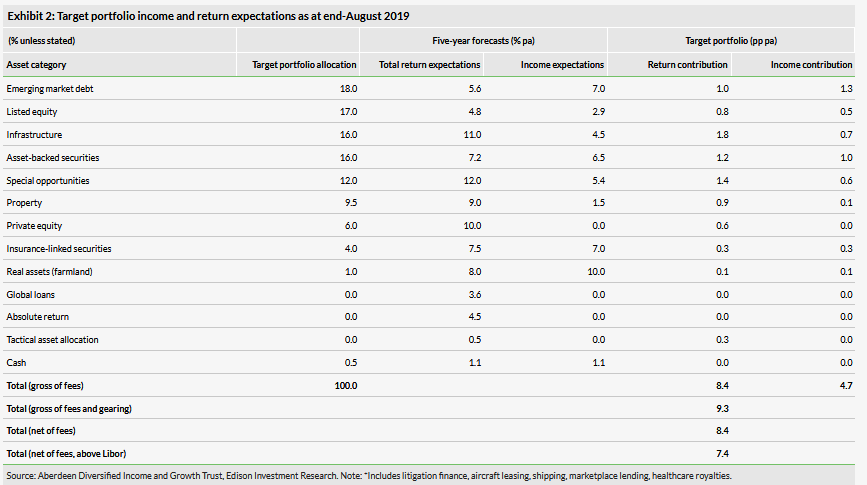
ADIG’s portfolio managers determine appropriate target portfolio allocations for each asset class based on five-year forecasts for annual total and income returns (see Exhibit 2), also taking into account available investment opportunities and the spread of liquidity across the portfolio. There is a balance between accessing the most attractive illiquid or long-term investment opportunities and retaining the flexibility to add value by altering the asset allocation. The portfolio is currently divided c 56%/44% between Aberdeen-managed and third-party strategies, versus a target split (when long-term investments are fully drawn) of c 60%/40%. It is expected over the long term that c 40% of ADIG’s portfolio will offer daily liquidity, with c 60% offering quarterly liquidity or better. Currently c 84% of the portfolio has at least quarterly liquidity (including 67% with daily liquidity), while c 16% has annual or less frequent liquidity.
As shown in Exhibit 2, the expected annual returns (net of fees and measured over a five-year horizon) from the target portfolio are 7.4pp above the five-year forecast Libor rate, comfortably exceeding ADIG’s aim of returning Libor +5.5% pa. However, the current portfolio is at or below the target weighting in the three asset classes with the highest return expectations (special opportunities, infrastructure and private equity). This is partly owing to the long-term nature of commitments to these assets, many of which are not yet fully drawn.
Current portfolio positioning
At 31 August 2019, there were 44 holdings in ADIG’s portfolio, with the top 10 making up 51.8% of the total, a slight decrease in concentration from 54.3% a year earlier. 15 of the 44 are longer-term investments, which currently (based on drawn funds rather than commitments) account for 21.6% of the portfolio, compared with a target allocation (once fully invested) of 41.3%. ADIG’s managers are happy with the roster of unlisted investments as it now stands, and do not envisage committing capital to any new longer-term investments until the existing investments have made substantial realisations.
Foster says the team has been pleased with the recent pace of investment by the longer-term holdings, and there has been some continued recycling from listed to unlisted funds. In terms of portfolio activity, ADIG has exited Foresight Solar Income Fund and substantially sold its holding in The Renewables Investment Group, and has recycled the proceeds into SL Capital Infrastructure Fund II. Foster says the progress towards the target weighting in longer-term funds is illustrated by this fund’s recent investments, which include two district heating systems in Finland, liquid storage in Europe and some Central European solar assets.
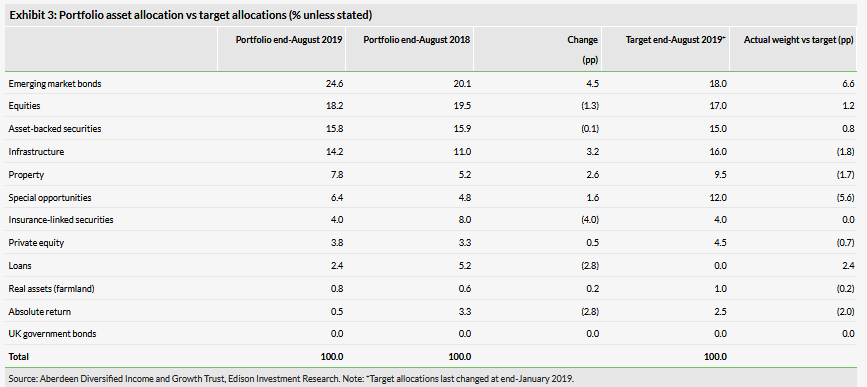
Elsewhere in the infrastructure allocation, Foster says Aberdeen Global Infrastructure Partners II now has five assets in construction or moving into operation. The now-complete Perth Stadium was owned jointly with John Laing Group, which has sold its stake to the Australian life insurance company AMP Group, thus establishing a third-party valuation. The manager adds: ‘This fund has preferred bidder status on a number of projects, primarily in transport. The same team also runs the Andean Social Infrastructure fund, which is yet to make an investment but is pretty close to signing a deal on an operational project. They are using their expertise from other countries and applying it to South America, targeting double-digit annual returns.’
Foster reports that the two ASI-managed unlisted property holdings – Aberdeen Property Secondaries Partners II and Aberdeen European Residential Opportunities Fund – are both making good progress. ‘Aberdeen Property Secondaries Partners II now has eight investments, up from three when we got involved, and it has already had a number of profitable realisations. It has recently made new investments in funds involved in Indian offices, Australian residential property, Spanish residential property and European logistics, as well as a small portfolio of funds in the final stages of wind-up.’ He adds that the team signed five deals over the summer, taking ADIG’s commitment close to being fully drawn. The Aberdeen European Residential Opportunities Fund, which converts commercial buildings into residential, now has 11 projects, in Denmark, Germany, the UK, Sweden and Finland. Foster comments: ‘There have been one or two where costs have come in higher than expected, so there has been something of a J-curve effect that has held back short-term returns, but we are confident it will deliver double-digit annual returns over the life of the investment.’
The portfolio managers see physical assets – property, infrastructure, transport (aircraft leasing and shipping) and real assets (farmland) – as ideally suited to ADIG’s investment approach, in that they are long term, offer attractive risk-adjusted returns and add considerably to portfolio diversification. Over time, they expect most of these investments to deliver double-digit percentage annual returns, net of fees. ADIG’s physical assets exposure has increased from 13.1% of net assets at the start of FY18 to 24.1% at 31 August 2019, as investment commitments have been drawn down and new investments made.
In private equity, the trust has recently made a $25m commitment to Fund IV of the Aberdeen Standard Secondary Opportunities Fund (SOF), which identifies stakes in maturing private equity funds that are nearing the end of their life, and buys them at a discount from investors who wish to recycle their capital rather than waiting for an exit. Realisations from existing mature private equity funds managed by HarbourVest, Mesirow and Maj (a Danish small-cap specialist) will be recycled into SOF. Foster says ADIG’s other private equity investment, a co-investment in aircraft leasing company TrueNoord, is also performing strongly.
The target allocation to insurance-linked securities was reduced from 8.0% to 4.0% following the issues at Markel CATCo, which now intends to wind up its listed funds and the 2018 unlisted fund, which makes up the bulk of ADIG’s exposure. Foster says the ADIG team is considering whether to invest in a new insurance-linked programme Markel Corp is launching, look for another manager in the sector, or recycle capital into other areas. ‘Ultimately, we like the uncorrelated nature of the asset class, and premiums continue to rise, but it has had a bad run over the last year,’ says the manager. He explains that currently about half of ADIG’s insurance-linked investments are held as collateral against increases in 2017/18 claims as these are finalised. The balance is on risk for the remainder of 2019. At the end of this year, any 2019 investments that are not involved in claims will be returned.
In the more liquid part of the portfolio, emerging market debt (EMD) remains the largest overall allocation, at 24.6% versus a target weighting of 18%. Foster says: ‘We have a well diversified emerging and frontier markets portfolio, generating mid-single digit returns, which is much more attractive than developed market bonds yielding, in some cases, less than zero. EMD is one of those markets which only appear in the headlines when the news is bad, but we think it offers diversification and attractive returns, and it has proved that over quite a long period.’ He adds that as the weighting is above the long-term target, the team has been taking profits and using the funds raised to invest in unlisted commitments.
Regarding the equity allocation (which has been reduced from 19.5% of the portfolio to 18.2% over the 12 months to 31 August 2019, versus a target weighting of 17.0%), the manager says that equities generally are fully valued but value-focused equities appear good value, ‘so we are sticking with our approach but keeping the equity weighting low’. He adds that the Aberdeen Smart Beta Low Volatility Global Equity Income Fund, which uses a factor-based approach including a bias to value, did not outperform at the end of last year as might have been expected when the equity market fell, and so far has not recovered to anywhere near the same extent. However, he argues, ‘with the valuation disparity between growth and value equities now close to record levels, now is not the time to change to a different equity approach and lock in the underperformance’.
See Exhibit 9 for a full portfolio listing (including target allocations for longer-term funds) at 31 August 2019.
Performance: Progress towards medium-term target

ADIG’s NAV and share price total returns (net of fees) since the change in strategy have lagged the target return of Libor +5.5% (Exhibit 5). There are two principal reasons for this: first, the time inevitably taken for the trust’s commitments to higher-return long-term investments to be drawn down and invested by the managers of the underlying strategies, and second, stock-specific issues with the allocations to insurance-linked securities and, to a lesser extent, litigation finance.

Insurance-linked securities (specifically the listed investment in CATCo Reinsurance Opportunities and the unlisted Markel CATCo Reinsurance Fund) have detracted by 4.7pp since ADIG’s inception, a larger negative contribution than the positive returns from any of the other portfolio categories (ADIG’s portfolio return for the period from March 2017 to 31 August 2019 was c 4.8%). This was as a result of insurance losses arising from an unprecedented number of natural disasters such as the California wildfires in 2018. More recently the losses have been smaller, at -0.5pp of the 3.8% portfolio return for 2019 to date (to 31 August), although a larger negative impact (-0.9pp) came from the special opportunities portfolio (see full portfolio listing in Exhibit 10), specifically from litigation finance, where ADIG holds the listed Burford Capital and the unlisted Burford Opportunity Fund. Burford Capital’s share price fell very sharply in August following the publication of a ‘short report’ by US research company Muddy Waters. Foster says: ‘We own the listed fund, whose share price has halved; we have had extensive discussions with the board, the manager and analysts on whether there is any veracity in Muddy Waters’ allegations, and most of them have proved to be without foundation. There is no doubt that Burford is a strong global leader in litigation finance, and we have been reassured by the recent changes in corporate governance and the way in which the substantive issues raised by Muddy Waters have been addressed. The early newsflow on the first investments made by the Burford Opportunity Fund is also very encouraging. We are convinced that, despite this recent setback, litigation finance remains an ideal asset class for ADIG.’
The best returns (+2.9pp) year-to-date have come from ADIG’s emerging market debt (EMD) allocation, where the managers currently see returns close to 6%, versus less than 1% for gilts and -0.5% for German bunds. Despite weakness a year ago as a result of issues in Argentina and Turkey, Foster says the EMD portfolio has delivered attractive returns, reflecting the fact that it is broadly spread across a range of countries. ‘We continue to have positive return expectations given countries are generally performing well in terms of the economic outlook,’ he says. He notes that there are some idiosyncratic political moves in some countries, including the recent sell-off in Argentina. However, ADIG currently has no Argentinian bond exposure, having reduced it substantially in July, taking profits to fund drawdowns from some of the longer-term unlisted investments.
Foster says performance from ADIG’s listed equity portfolio – held via the Aberdeen Smart Beta Low Volatility Global Equity Income Fund – has been ‘something of a disappointment’ year-to-date. The fund focuses on a number of risk premia that have historically offered attractive long-term returns – particularly value, small size and quality factors. ‘Academic research shows that these outperform over the long term, but this year in particular, one of the upshots of the weakness in developed market bond yields is that growth equities have re-rated sharply against value equities, so value has underperformed substantially this year,’ says Foster. ‘As such, our approach has underperformed the global equity index by c 10pp year-to-date, although it has done a bit better recently as value has snapped back.’ The listed equity portfolio has contributed +0.7pp of ADIG’s 5.2% year-to-date portfolio return.

ADIG’s share price has underperformed its NAV over the past year, with the shares moving from a small premium to a wider-than-average discount. With the bad news from insurance-linked and litigation finance investments now arguably fully reflected, and with the pace of investment in higher-return longer-term investments accelerating, we believe there is significant scope for the discount to revert to its longer-term range of c 3–5%.
Discount: Widening in recent months

At 26 September, ADIG’s shares traded at a 9.2% discount to cum-income NAV. Having traded at a small premium as recently as March 2019, the shares de-rated markedly over the summer, which Foster says is partly attributable to a sale during a quiet period of the year by a shareholder who was moving to a more overtly defensive asset allocation, and partly as a result of weakening sentiment towards the trust caused by the disappointing exposure to insurance-linked securities. BIST had previously (and somewhat unsuccessfully) followed a nil-discount policy, but since the merger with AUKT, ADIG has targeted a maximum discount of 5% in normal market conditions. Against this backdrop, share repurchases have accelerated recently, with 5.5m shares bought back since the start of August, at a cost of £5.8m. As well as acting as a marginal buyer in the market, ADIG’s board sees building greater awareness of the strategy and the managers’ long-term track record as key to bringing the trust’s discount back into the target range. Average discounts over both the short and longer term have been below the 5% maximum target, at 3.2%, 4.8%, 4.2% and 4.1%, respectively, over one, three, five and 10 years.
Capital structure and fees
ADIG is a conventional investment trust with one class of share. At 26 September 2019 there were 323.0m ordinary shares in issue. The board has the authority to buy back up to 14.99% of the outstanding shares or allot up to 10% of the share capital annually, to manage a discount or a premium. So far in FY19 (ending 30 September), 2.2m shares have been issued at a premium and 7.7m have been bought back at a discount to NAV, leading to an overall reduction of 5.6m shares, or 1.7% of the share base at the start of the year. Gearing is permitted up to 20% of net assets and is available via a £60m issue of bonds with a coupon of 6.25%, maturing in 2031. This is equivalent to c 15.3% gross gearing; the net gearing figure of 12.1% at 31 August 2019 reflects the offsetting effect of some cash holdings.
ASI, ADIG’s investment manager, is paid an annual management fee of 0.5% of net assets up to £300m and 0.45% thereafter. Investments in ASI funds that invest directly in alternative assets, such as infrastructure or property, are charged at the lowest institutional rate, while fees charged on ASI funds that do not invest directly in alternatives are waived or rebated to ADIG. There is no performance fee. Management fees and financing costs are charged 60% to capital and 40% to revenue (with effect from 1 October 2018; previously 65:35). As at end-H119, ADIG’s ongoing charges were 0.85%, a slight decline from 0.88% at end-FY18.
From the 2020 AGM, ADIG will hold an annual continuation vote.
Dividend policy and record
As part of the strategic review that saw the trust’s mandate move to ASI, ADIG rebased its dividend in FY17 to reflect the higher level of equity market volatility and lower yields on ‘risk free’ assets such as government bonds. It now aims to pay a desirable dividend consistent with its underlying portfolio yield. Dividends are paid quarterly, in March, July, October and January. The FY18 total dividend of 5.24p was 1.17x covered by revenue returns and the trust also expects to pay a fully covered dividend for FY19. So far three interim dividends of 1.34p each have been declared, with a fourth expected at the same level, to bring total FY19 dividends to 5.36p, a 2.3% increase on FY18. This increase is above the 1.7% rate of UK consumer price inflation over the year to 31 August 2019. At end-H119 (31 March), ASI says ADIG had revenue reserves equivalent to 2.0x its last 12 months’ dividends. Based on the current share price, ADIG’s shares have a yield of 4.9%, the second-highest in its Association of Investment Companies Flexible Investment peer group.
Peer group comparison
In Exhibit 8 we show ADIG in the context of its Association of Investment Companies Flexible Investment peer group (excluding funds under £100m market cap). The sector contains a diverse group of funds that broadly fall into the categories of multi-asset, multi-manager or absolute return, although each strategy is quite distinct from the others, and as such performance can diverge markedly between funds. ADIG’s NAV total return performance has been affected by the losses from Markel CATCo and its listed funds, which suffered as a result of storms and wildfires in 2017 and 2018. This has dampened returns over both one year and since ASI took on the mandate in April 2017. Three- and five-year returns are also below average, but this partly reflects the poor performance record of BIST. Like ADIG, most of the peer group has produced single-digit returns over the past 12 months, in part reflecting the tendency of funds in the Flexible Investment category to be less than fully exposed to equities, at a time when global stock markets have bounced back strongly from the lows of Q418. Foster says that at c 18%, ADIG’s equity exposure is the lowest in the peer group.
ADIG’s ongoing charges are well below the sector average, and it does not charge a performance fee. It currently has the second-highest level of net gearing in the group, with the majority of peers having no net gearing. ADIG’s discount to NAV has widened substantially over the past six months, although it remains well below the peer group average. At 4.9%, ADIG’s dividend yield is nearly twice the peer group average.

The board
Having completed its process of board refreshment, ADIG currently has six directors, although this will fall to five following the retirement of chairman James Long at the February 2020 AGM. Long will be succeeded as chairman by Davina Walter (currently the senior independent director), who was appointed to the board of ADIG in February 2019. She in turn will be succeeded as senior independent director by Julian Sinclair, who has served on the board since July 2015, and will (following Long’s retirement) be the only director whose appointment dates from the trust’s time as BIST. Tom Challenor joined the ADIG board in April 2017, having previously been a director of Aberdeen UK Tracker Trust. The two newest directors are Anna Troup and Trevor Bradley, who were appointed with effect from 1 August 2019. Four directors – Ian Russell, Paul Yates, Kevin Ingram and Jim Grover – have retired from the board since 31 October 2018. The directors have backgrounds in asset management and corporate finance.
Appendix: Full portfolio listing
